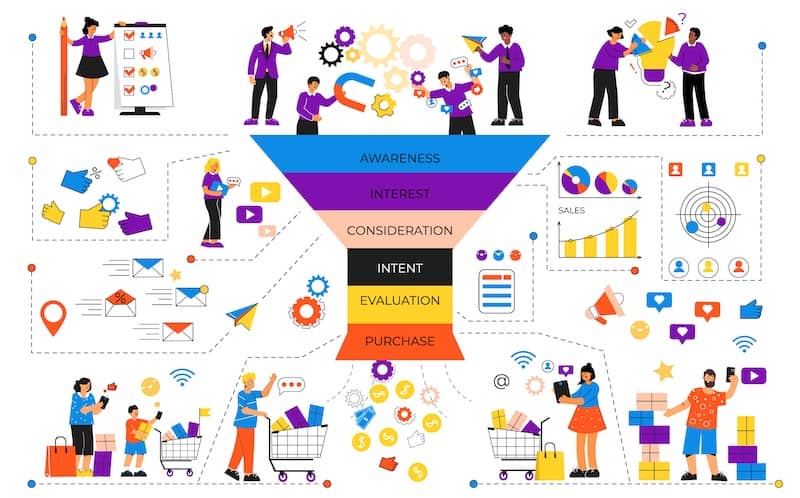It’s one thing to have a great business idea and another to know how to attract and keep the right audience for your product or service.
The funnel marketing software you choose can make all the difference in turning visitors into customers. The goal is building funnels, so partnering with the right platform to create, manage, and optimize your funnels matters.
Whether you’re selling to other businesses (B2B) or directly to customers (B2C), think about your business’s unique needs when picking the best software. You might be a startup looking for powerful tools without breaking the bank. Whatever your situation, there’s a funnel solution made for you.
Keep reading for tips on choosing the right funnel software to grow your business.
What is Sales Funnel Software?
Funnel-building sales software automates the process of turning potential customers into paying ones, making the journey through your sales pipeline smoother and more efficient.
While it’s possible to build your funnel using a series of DIY methods, this strategy often takes considerably more time. A more comprehensive sales funnel tool can dramatically streamline the process, leading to higher conversion rates and increased sales.
How to Use Sales Funnel Software
Sales funnel software is most effective when the right processes are in place. While relatively simple in practice, the method behind the process must be strategic. Consider this tactical three-part framework:
- Develop a Sales Funnel—Define the different stages of your sales process. These stages might vary slightly based on your business, but generally consist of:
- Awareness
- Interest
- Consideration
- Intent to purchase
- Action
- Add Your Leads—Integrate the sales funnel software with your lead generation tools and strategies.
- Track and Evaluate—Keep an eye on your sales progress and assess your results with the software’s tracking and reporting tools.
10 Features Your Funnel Marketing Software Should Have
Now, on to those 10 features you want in a funnel software solution. Pick one that has:
1. Email Campaign Automation
The best email campaigns use triggers to automatically add people to email lists when they take specific actions, like clicking a link or filling out a form. Once they express interest, the automation flow sends them follow-up emails, guiding them down the sales funnel. Without automation, manually managing follow-ups would be super time-consuming for employees and increase the chance of potential leads slipping through the cracks.
2. Funnel Blueprint
A funnel mapper lets you quickly design automated sequences by mapping out each step of your marketing plan. You can also use a simulator to predict costs and profits at each stage. This data helps you see and understand how to build a strong, successful sales funnel within budget.
3. Funnel Page Builder
Most sales funnels include special pages designed to encourage a specific action. A good funnel software should have an easy drag-and-drop builder for creating and optimizing these pages for lead generation, as they are updated frequently based on campaigns and promotions. It should also offer forms to collect customer information and connect seamlessly with your email marketing tools.
4. Pre-built Templates
Using pre-made templates for sales funnels and campaigns can save you time. These templates come with ready-to-go designs and automation, so you can focus on optimizing your campaign rather than getting caught up in design details.
5. Lead Management Integration
Lead management software helps you organize customer information, such as emails and purchase history. It makes it easier to sort and target your leads. Simplify lead nurturing using funnel software with built-in lead management, so you don’t need extra subscriptions.
6. Checkout System Integration
It’s smart to pick sales funnel software with a built-in checkout. This option saves you from using separate platforms like Shopify or dealing with complicated payment setups. With secure payment options, a built-in checkout lets customers buy quickly and easily. One-click checkout and ready-made templates will save you and your customers time.
7. Sequence Creation
A sequence builder lets you easily set up and adjust your sales funnel. Without it, connecting emails and landing pages can be confusing and lead to mistakes. You can quickly add, remove, or reorder steps with a simple drag-and-drop builder. The automation options make it quick and easy to follow up with customers or adjust your strategy if something isn’t working.
8. Advanced A/B Testing
A/B testing helps you see which page, email, or ad version works better. Improve your sales funnel by testing two options and getting more conversions. It’s useful for ads, emails, landing pages, checkout pages, and forms. Good software will track your tests and help optimize your campaign.
9. Live Analytics Monitoring
Sales funnel analytics track customers’ actions before they exit the sales funnel. The software metrics can show user behavior inside the funnel and may even track actions from ads and social media. It gives key data like conversion times and success rates in one efficient tool.
10. Integration with Third-Party Tools
This capability allows your funnel software to connect with other platforms, such as payment processors or social media, creating a smooth workflow across your business.
Simplify Your Funnel, Amplify Your Growth
Choosing the right software for your business needs doesn’t have to feel overwhelming. Funnel marketing software can help you save time by automating and improving your funnels. It streamlines the entire process, from attracting leads to closing sales, so that you can focus on growing your business.
Try ClickFunnels for Free, and Build Your Landing Page in Minutes








